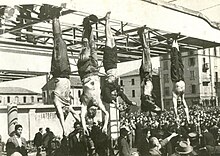Excellent analysis of the situation in Eastern Europe by Bill Browder, founder of London-based Hermitage Capital Management:
I’m afraid that, based on the reasons behind Putin’s motivations for invading Ukraine in the first place, there is no chance that he will back down. To understand this, all it takes is a simple analysis of how this crisis unfolded.
First, Putin didn’t start this war because of NATO enlargement or historical ties to Crimea, as many analysts have stated. Putin started this war out of fear of being overthrown like Ukrainian president Yanukovych in February 2014. Yanukovych had been stealing billions from the state over many years, and the Ukrainian people finally snapped and overthrew him. Compared with Putin, Yanukovych was a junior varsity player in the field of kleptocracy. For every dollar Yanukovych stole, Putin and his cronies probably stole 50. Putin understands that if he loses power in Russia, he and his underlings will lose all the money they stole; he will lose his freedom and possibly even his life.
I believe that Bill is right. Putin was not reacting to EU or NATO encroachment (they were never a threat), but to Maidan. Especially when we read Michael McFaul’s (former ambassador to Russia) summation of Putin: “He is obsessed with the CIA…..With respect Ukraine he believes the US led the coup in the Ukraine. The Ukrainians had nothing to do with it. It was all the CIA.”
….. Putin has never dealt with economic chaos before. Though some may argue that this will bring him to the table to negotiate with the West, in my opinion any negotiation would be seen as a sign of weakness and is therefore the last thing Putin would want to do.
Putin’s only likely response is to escalate in Ukraine and possibly open up new fronts in other countries where there are “Russians to protect.” But doing so will only harden the sanctions, leading to further economic pain in Russia — and further military adventures to distract Russia’s people from that pain.
I cannot imagine a scenario in which there is any compromise, because for Putin compromise means being overthrown. Judging from all of his actions to date, he is ready to destroy his country for his own self-preservation.
We should start preparing ourselves for a war in Europe that may spread well beyond the borders of Ukraine. The only Western response to this has to be containment. This all may sound alarmist, but I’ve spent the past eight years in my own war with Putin, and I have a few insights about him that are worth knowing.
In Putin’s mind, he is fighting for survival. The US/EU/Nato and Ukraine are just a convenient scapegoat. His real enemy is the Russian people. This 1945 image of Benito Mussolini, his mistress Clara Petacci, and three others hanging outside a petrol station in Milan must haunt his dreams.

When they realize they have been duped, the anger of the Russian people will be palpable.
Read the full article at Unhedged Commentary: Putin Will Never Back Down | Institutional Investor's Alpha.










































